
Port-A-Potties are Really Mobile Outhouses
(written by Dr. Les Crocker, UWL Emeritus Professor of Art History)
Dedicated to Anita who unwittingly provided the inspiration.
The grass is greener where the outhouse stood (unsubstantiated but perhaps a take-off of a poem by Walt Whitman).
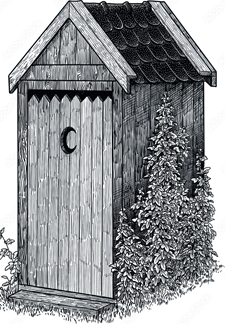
An illustration of a typical American outhouse that could be found almost anywhere from the east coast to the Great Plains to the west coast before 1880.
The other day I mentioned to a colleague that I had spent forty-five minutes in line, properly spaced of course, at my local DMV office waiting to get new license plates. Her pleasantly snarky comment was, “I hope they had port-a-potties.” She was right, of course, and I think of that when I see the miles long lines of cars with people waiting to get tested for the [Covid] virus. Those of us living outside the city make a point of waiting for that second cup of coffee to work its way through the system before embarking on a trip to town and the rest room at the library was often a first stop.
For some reason the mention of port-a-potties reminded me that they are nothing more than mobile outhouses. That reminded me that while the grass was not always greener on the other side of the fence, it was always greener where the outhouse had been.
Not long after I moved to an old farm north of Houston, Minnesota, a guy came down the road on a tractor with a sickle bar, cutting roadside weeds. I lived at the end of the road and he stopped for a cigarette and some talk. He had owned the property at one time and mentioned that he had used his Korean War bonus to put indoor plumbing in the house. That would have been in the mid-1950s, not so long ago for some of us. We made a few comments about the joys of an outhouse, and he pointed to a patch of yard about a hundred feet from the house and said “It was over there.” So, that was why my lawn mower always bogged down when cutting that section of the yard. The grass was not only greener, it was thicker and tougher.
He told me a story, recounted to him by an older resident, who enjoyed the sun coming up through the cracks in the wall of the outhouse. There are always flies around an outhouse, no matter how much wood ash or lye you use. Where there are flies there are spiders and spider webs. In the winter, heat from the waste pit rises and moisture condenses on the cold spider webs. The warm air carries uric acid and the spider webs become yellow. This old fellow felt there was nothing grander than the rising sun coming through the golden spider webs of winter.
Maybe for him, but not so much for me. I've never used an outhouse in a Wisconsin winter but I've used a slit trench at deer camp. No, thank you. I worked at a boy scout camp for several summers and even with the hospital staff diligently cleaning the four-holers and scattering lye in them, by mid-August you didn't need a map much less a GPS device to find a place to contemplate the world.
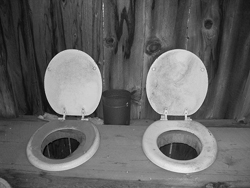
Families were large before the 1920s and sometimes outhouses could accommodate more than one person at a time without any privacy. It was generally not a place where people lingered longer than necessary.
When I arrived in La Crosse in 1969 there were at least two old guys who preferred their outhouse to indoor plumbing in spite of the health inspector. An old barn that had become a garage sometimes included an outhouse for the hired hands and continued in use with no one the wiser.
Which is all to remind us that in the past La Crosse smelled bad. With several thousand outhouses that was just the way things were. Besides the human wastes a medium sized buggy horse produced about twenty to thirty pounds of waste a day, large horses for the beer wagons dropped about fifty pounds a day and several gallons of liquid. With about two thousand horses in La Crosse during the 1880's.... well, you can do the math. Since La Crosse is built on a sand bar at the base of the bluffs you can thank the sawdust from the mills and the waste from horses for whatever topsoil you have.
In the wet spring and fall streets became 'muddy' but a lot of that so-called mud was horse manure and urine mixed with the sandy soil. In the downtown straw was sometimes spread on the street, which added some fiber to the mud. In the summer it dried and the horse hooves and wagon wheels broke it into fine dust that went everywhere. The heavy drapes favored at the time helped to keep out the dust but, like the stink of outhouses, it was everywhere.
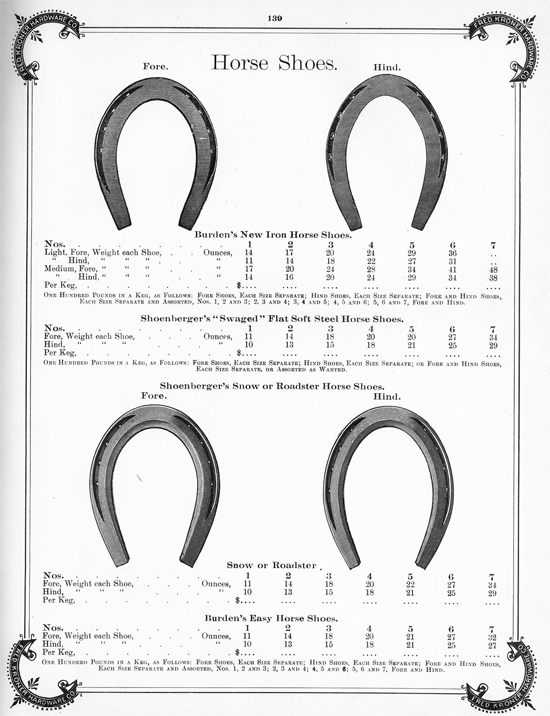
A page from La Crosse’s Fred Kroner Hardware catalog of 1901 showing some of the horse shoes available for purchase.
La Crosse not only smelled bad because of horse manure and outhouses, the waste was dangerous. The sandy soil and high-water table made it easy to drill a well near the back door. But the liquid wastes from the barn and outhouse could also travel through the sand and early accounts of the city indicate that people had a lot of 'stomach problems' before city water became available.
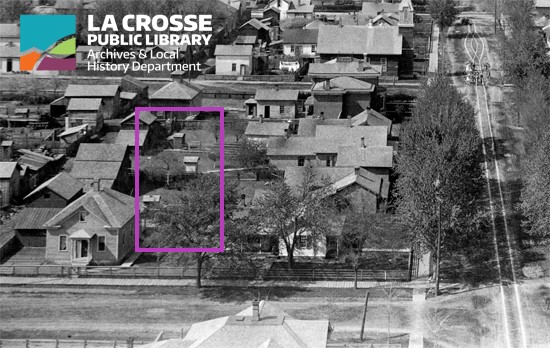
This is a partial view of a larger photograph that was taken from an arc light located on Jackson and 7th Street South looking north. The street car lines on the right side of the photograph are 7th Street. Most residences in this scene have outhouses if you can spot them. They usually have a vent pipe but not always, and were never connected to the house. A small room attached to the backside of a house and having a chimney was usually a summer kitchen and not the outhouse. How many can you spot?
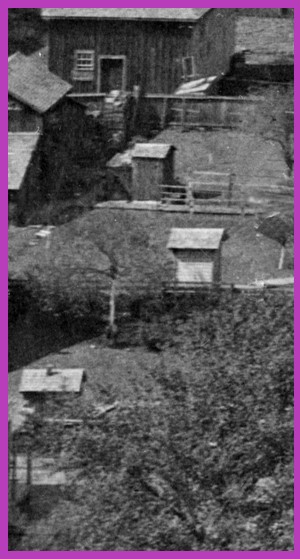
The same view only highlighting at least three outhouses. All had plank walkways from the house that rose up above ground level for the very reasons Dr. Crocker points out in this narrative!
La Crosse not only smelled bad it was dark. At my house, north of Houston, I could go out the back door and see the lights of the television Channel 19 towers on the ridge to the northeast. There was always a haze of light beyond the towers, especially if the clouds were low, the lights of La Crosse. We are all aware that there is almost no place on earth that is truly dark anymore. Photos from space show brilliant pools of light from cities and strings of lights connecting cities. But it was not always so.
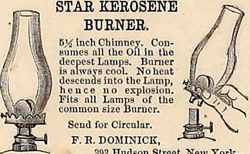
A view of an ad in Harper’s Weekly magazine of 1867 showing a style of kerosene lamp with a glass chimney.
If you visit Greenfield Village in Dearborn, Michigan, you will find several rooms filled with a variety of lamps that burned candles, whale oil, kerosene or sometimes gasoline. In the early years, gasoline was an unwanted byproduct of distillation. It burned too hot and there was little use for it until automobiles came along. Most people move through the rooms of the museum quickly, after all, they are just a bunch of old lamps. Some are plain and utilitarian while others are gorgeous sculptures in glass or metal. They represent the nineteenth century's search for better and safer light. Flat wicks, round wicks, adjustable wicks, multiple wicks, pressurized air feeds, tall chimneys for better draft, short chimneys for safety. Every basement inventor had an idea for a better lamp and like a better mouse trap it could make you a fortune. Lamps were better and safer than candles. First came whale oil lamps that created an east coast industry of sailing ships and rendering tanks (read Moby Dick) but over time, sperm whales became increasingly rare and their oil became more expensive. After the Civil War 'coal oil' became widely available and lighting improved, but not by a lot.
Chimney glass was made thinner and tougher to dissipate the heat but chimneys got very hot and could ignite a blowing curtain or leave a nasty burn on your hand or arm. Metal lamps were advertised for their safety. A dropped glass lamp could spread burning kerosene across a rug or wooden floor very quickly. Pressurized lamps added more air to the burning liquid and produced a hotter and brighter flame, but poorly built ones could explode, flinging burning liquid around the room.
Kerosene stinks and a poorly adjusted wick smokes. After a winter of long nights spring cleaning was a necessity. The heavy drapes, rugs and upholstered furniture smelled of kerosene and at the very least needed a good airing out. Dust from the streets had to be beaten out of the rugs.
So, the next time someone starts talking about the “good old days” remind them that La Crosse, like all cities of the time, was both dark and smelled bad.

